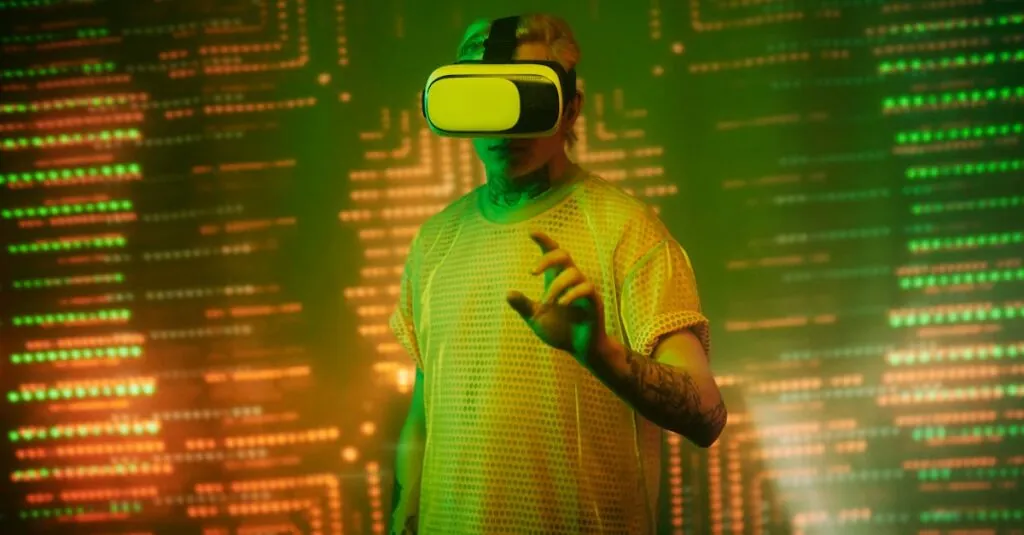Table of Contents
ToggleVirtual reality isn’t just for gamers anymore; it’s stepping into the spotlight and ready to transform everyday life. Imagine slipping on a headset and teleporting to a tropical beach while still in your office cubicle. Sounds dreamy, right? As VR technology evolves, it promises to reshape how we work, learn, and even socialize.
Overview of VR Technology
Virtual reality (VR) technology provides immersive experiences that transport users to different environments. Users can engage in simulated worlds that feel real through headsets and motion tracking. Various industries now leverage VR, including healthcare, education, and entertainment.
The application in healthcare offers innovative training solutions, allowing medical students to practice procedures in a risk-free environment. Education benefits from VR by providing interactive lessons. Learners can explore historical sites or view complex scientific concepts in three dimensions, enhancing understanding.
Entertainment continues to be a dominant field for VR, with gaming at the forefront. Gamers experience heightened realism as they interact with richly detailed virtual worlds. Beyond gaming, VR offers unique cinematic experiences, where viewers feel as if they are part of the film.
Corporate training utilizes VR to improve employee skills and safety protocols. Companies create realistic scenarios, enhancing decision-making capabilities in a controlled setting. Such training reduces costs and increases efficiency over traditional methods.
Social interaction changes with VR, as individuals can meet in virtual spaces regardless of geographical location. Friends can share experiences in a simulated environment, enhancing connection. Events hosted in VR, such as conferences and concerts, create new opportunities for engagement.
Challenges exist, including high costs and the need for advanced hardware. Developers continuously strive to innovate, making VR more accessible. As technology evolves, the potential for VR to penetrate everyday life grows, fostering new ways to work, learn, and socialize. Overall, VR technology stands poised to redefine numerous aspects of modern living.
Current Trends in VR Technology
VR technology is rapidly evolving, with significant trends shaping its current landscape. These trends highlight advancements in hardware and innovations in software that promise to enhance user experiences.
Advancements in Hardware
VR hardware is undergoing continual advancements, leading to improved user experiences. Lightweight headsets now offer enhanced comfort, allowing users to engage in longer sessions without discomfort. High-resolution displays increase visual clarity, providing immersive environments that feel realistic. Moreover, hand tracking and haptic feedback technologies add layers of interaction, letting users feel as if they are truly part of the virtual world. Additionally, wireless capabilities are becoming standard, eliminating the tangles of cables and allowing for more freedom of movement. These innovations are fostering greater adoption of VR across various sectors, from gaming to education.
Innovations in Software
Software innovations are transforming how users experience VR. Enhanced platforms are now supporting more complex simulations and interactive environments, enabling richer storytelling and engagement. Collaborative tools are in demand, allowing multiple users to interact in shared virtual spaces seamlessly. New educational applications are also emerging, leveraging gamification to improve learning outcomes. Additionally, VR content libraries are expanding, featuring diverse experiences that cater to various interests, such as travel or historical exploration. Mixed reality applications are becoming more prevalent, blending physical and virtual elements to enhance user interaction. As software continues to evolve, the potential applications for VR technology expand significantly.
The Future of VR Technology
VR technology continues to expand, shaping various aspects of daily life. Its applications are not limited to entertainment; numerous industries are harnessing VR’s capabilities.
Potential Applications
Healthcare uses VR for simulation training, allowing medical students to practice without risks. Education benefits by providing interactive lessons, enabling students to explore complex topics in engaging environments. In architecture and real estate, VR allows clients to tour properties virtually, enhancing decision-making. Retailers utilize VR to create immersive shopping experiences, allowing customers to try products in a virtual space. Event organizers enhance participation through virtual concerts and conferences, connecting people worldwide. By integrating VR into employee training, organizations improve skill development and workplace safety. Education-focused platforms use gamification to enhance engagement. Each application reveals the potential of VR to transform traditional practices into innovative experiences.
Challenges Ahead
Virtual reality faces several challenges that could impact its future development and adoption. Addressing these obstacles is essential for broader integration into everyday life.
Technical Limitations
High costs of advanced hardware remain a primary barrier to widespread VR use. Users often require powerful computing capabilities, which adds to the financial burden. Compatibility issues among various devices can complicate the user experience, resulting in fragmented ecosystems. Additionally, the development of realistic, immersive content presents its own challenges, often demanding significant resources. Latency issues can hinder the seamless experience that users expect, causing disruptions in immersion. As the technology evolves, overcoming these technical limitations is crucial for broader embrace and applicability.
Market Adoption
Achieving widespread market adoption requires overcoming user skepticism toward new technologies. Educating potential users about VR’s benefits helps dispel misconceptions. Organizations must emphasize successful case studies that demonstrate VR’s effectiveness in various sectors. Limited access to VR experiences can further deter potential users; exposure remains vital for interest and acceptance. Lastly, addressing concerns about motion sickness and other physical discomforts enhances user confidence. Streamlined onboarding processes can ease users into these technologies, paving the way for greater acceptance and integration.
The Impact of VR on Society
Virtual reality technology significantly influences various aspects of society. Education transforms through immersive learning experiences. Students explore historical sites or complex scientific concepts in three dimensions, enhancing comprehension. Healthcare training utilizes VR, allowing medical students to practice procedures in risk-free environments, ultimately improving patient care.
Corporate training experiences shift with VR, offering realistic scenarios for skill development. Employees engage in simulations that enhance decision-making, leading to cost savings and increased efficiency. Social interactions evolve as individuals meet in virtual spaces, fostering connections regardless of geographical barriers. Virtual events like conferences and concerts provide new engagement opportunities, enriching community experiences.
VR also impacts mental health treatment by offering therapeutic tools that simulate controlled environments. Therapists use VR for exposure therapy, helping patients confront fears in a safe setting. As technology advances, the demand for high-quality content grows, pushing developers to create innovative experiences. Mixed reality applications integrate physical and virtual elements, fostering deeper interaction.
Barriers remain, including high costs and the need for advanced hardware. Users often face financial burdens from powerful computing requirements. Compatibility issues complicate the experience, potentially deterring adoption. Additionally, concerns about motion sickness and physical discomfort can hinder user engagement.
Educating users on VR benefits is crucial. Highlighting successful case studies can help dispel misconceptions and foster acceptance. Limited exposure reduces interest, emphasizing the need for accessibility. Streamlined onboarding processes can boost user confidence and encourage integration into everyday life. Emphasizing these factors presents a promising future for VR technology in society.
The future of VR technology holds immense promise as it continues to reshape various aspects of life. With advancements in hardware and software, users can expect more immersive and interactive experiences across industries. As VR becomes more accessible, it’ll likely enhance education, healthcare, and social interactions, creating opportunities that were once unimaginable.
However, overcoming existing challenges is crucial for widespread adoption. Addressing concerns related to costs, compatibility, and user comfort will play a significant role in shaping the trajectory of VR. As these hurdles are navigated, the potential for VR to enrich daily life and foster deeper connections will only grow. The next few years could see VR transitioning from a niche technology to a fundamental part of everyday experiences.




